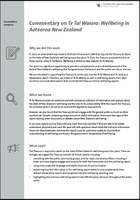Summary of our report
Why we did this work
 In 2020, an amendment was made to the Public Finance Act 1989 that requires the Treasury to report on the state of New Zealand’s well-being every four years. In 2022, the Treasury produced the first of these reports called Te Tai Waiora: Wellbeing in Aotearoa New Zealand (Te Tai Waiora).
In 2020, an amendment was made to the Public Finance Act 1989 that requires the Treasury to report on the state of New Zealand’s well-being every four years. In 2022, the Treasury produced the first of these reports called Te Tai Waiora: Wellbeing in Aotearoa New Zealand (Te Tai Waiora).
The report is a significant opportunity to provide a comprehensive and trustworthy account of the state of New Zealand’s well-being that the government, Parliament, and the public can rely on and use.
We are interested in supporting the Treasury to continually improve Te Tai Waiora and its value as a stewardship report. Therefore, we looked at Te Tai Waiora, as well as well-being reports from other countries, to provide observations that could help the Treasury’s future well-being reports.
What we found
Te Tai Waiora provides an extensive and well-considered collection of information and analysis about the state of New Zealand’s well-being and the risks to its sustainability. With this report, the Treasury has achieved what it set out to do and met the legislative requirements.
However, we also found that the Treasury did not engage with the general public as much as other countries do. Despite containing a large amount of useful information, there were few signs of the report starting wider discussions or debates about New Zealand’s well-being.
In our view, reports such as these will only reach their full potential if they are able to be widely understood, discussed, and used. We were left with questions about what the technical information means for New Zealanders and how the report could be used more widely to improve their understanding of well-being and trust in the government’s stewardship of well-being.
What next?
The Treasury is required to report on the state of New Zealand’s well-being every four years. There are changes we suggest the Treasury consider for future reports, including:
- consulting with the public, community groups, and iwi, hapū, and whanau Māori, including a wider and more aligned engagement process for both the frameworks and the well-being report;
- using more accessible language and helpful channels of communication;
- explaining how the information in the well-being report relates to and complements other relevant stewardship reports and recognised national well-being reporting; and
- highlighting how previous well-being reports have affected policy decisions throughout the public sector.

